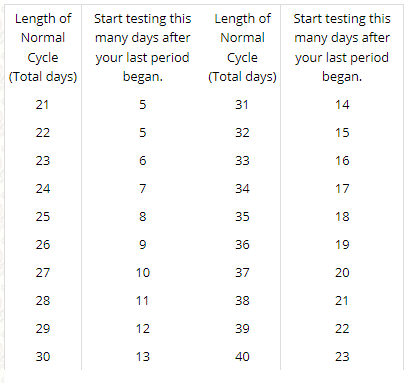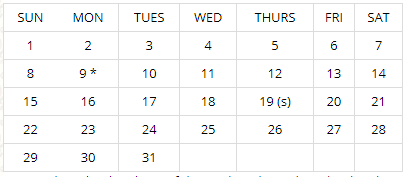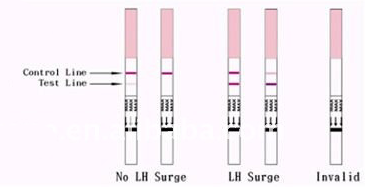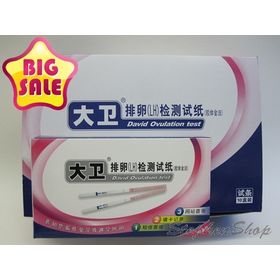|
The David LH Ovulation Test Strip will help you detect the time when you are most fertile and most likely to become pregnant. Luteinizing hormone (LH) increases dramatically, known as the LH Surge, just before women's most fertile days of the month. This LH increase triggers ovulation which is when the egg is released from woman's ovary. The egg can only be fertilized 6 to 24 hours after ovulation and use of Ovulation test strips can be a very valuable tool in helping to achieve pregnancy.
The best times to test are between 11am and 3pm and 5pm and 10pm. If you want to make sure that you catch your surge, you may want to test twice a day, once in the earlier time frame and the other in the later time frame. Please keep in mind that while you may have the initial surge of LH earlier in the day if testing via blood tests, you will not get a positive result on the ovulation test until 4-5 hours later when the surge actually reaches your urine.
Before You Begin
-
Read all these instructions fully before starting your test.
-
Do not open the foil packet until you are ready to perform the test.
-
Do not use the LH One-Step Ovulation Test Strip beyond the expiration date printed on the package.
-
Store tests at room temperature (below 86 degrees F). Do not freeze.
-
Early morning testing is not recommended as most women experience a blood LH surge but it does not show up in the urine until later in the day.
-
The best times to test are between 11am and 3pm and 5pm and 10pm.
-
Some women have found that their best sample is after 12 noon.
-
Test at the same time each day.
-
Reduce your liquid intake for 2 hours before testing, since drinking excessive amounts of liquids can dilute the LH in your urine yielding a negative result when it should be positive.
When to Begin Testing
To find out when to begin testing, determine the length of your normal cycle. The length of your cycle is from the beginning of one period (the day of first bleeding) to the day before the beginning of the next. Count the first day of bleeding or spotting as day one (1). If your cycle length is irregular, that is, if it varies by more than a few days each month take the average number of days for the last 3 months. Use the chart shown to work out the day you should begin testing. The day you begin testing is listed opposite the number of days in your normal cycle.

For example, if your period normally begins every 28 days, you should begin testing eleven (11) days after the beginning of your last period.

Note in the calendar above: If the ninth ( 9th ) in the calendar above is the first day (day one *) of menstrual bleeding, then the 19th, or day eleven, of your cycle is the day to begin testing (s).
Instructions
-
Bring the test pouch to room temperature. Collect urine into a clean container (such as plastic cup). The best way to collect sample is by placing a cup in the middle of urination process. To begin testing, open the sealed pouch by tearing along the notch. Remove the test from the pouch when you are ready to use it.
-
Immerse the strip into the urine with the arrow end pointing toward the urine. Do not immerse past the MAX (maximum) line. Take the strip out after 7 - 10 seconds and lay the strip flat on a clean, dry, non-absorbent surface (e.g., mouth of the urine container). You will see the urine start travelling up under the tip of the test.
-
Wait for colored bands to appear. Depending on the concentration of LH in the test specimen, positive results may be observed in as little as 40 seconds. However, to confirm negative results, the complete reaction time of 10 minutes is required. Do not read results after more than 30 minutes.
-
After interpreting the test results, discard the test strip.
|

|
Interpretation of the Test as the LH Ovulation Test Strip begins to work, a colored band will appear in the upper section of the result area to show that the test is working properly. This band is the Control Line. The lower section of the result area indicates the test results. If another colored band, the Test Line, appears at the lower section of the result area and is of equal or darker color than the Control Line, the results should be interpreted as a positive test.
Positive Result (LH Surge)
If two color lines are visible and the test line is equal to or darker than the control line, one will probably ovulate in the next 24-48 hours. If one wants to be pregnant, the best time to have intercourse is after 24 hours but before 48 hours.
|
|
Negative Result (No LH Surge)
Only one color line appears on the control region or the test line is present but lighter in color intensity than the control line. There is no LH surge even if two lines present - as long as test line is fainter than the control line the result is negative.
Invalid Result
No visible lines in the control and test regions. Make sure to follow the above specified instructions for optimum results. You have to repeat the test by using a new LH Ovulation Test Strip.
When to Stop Testing: Unless otherwise specified by your doctor, stop testing once the LH surge is detected.
|












